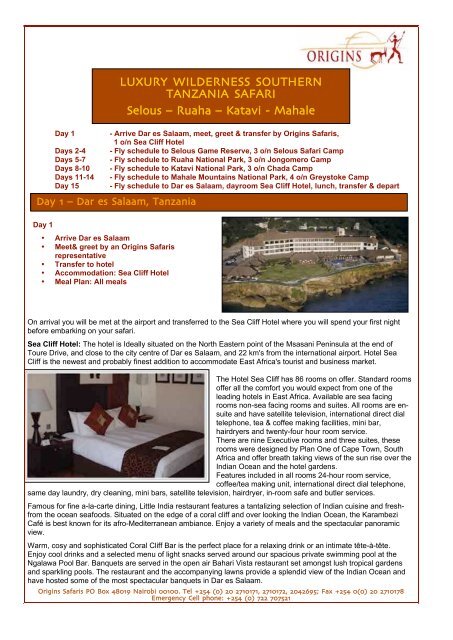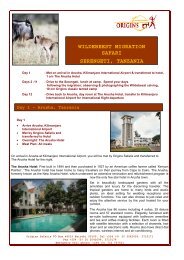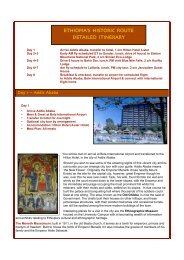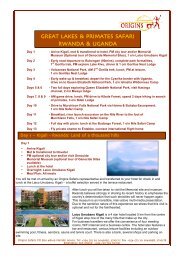LUXURY WILDERNESS SOUTHERN TANZANIA ... - Origins Safaris
LUXURY WILDERNESS SOUTHERN TANZANIA ... - Origins Safaris
LUXURY WILDERNESS SOUTHERN TANZANIA ... - Origins Safaris
You also want an ePaper? Increase the reach of your titles
YUMPU automatically turns print PDFs into web optimized ePapers that Google loves.
Day 1 - Arrive Dar es Salaam, meet, greet & transfer by <strong>Origins</strong> <strong>Safaris</strong>,1 o/n Sea Cliff HotelDays 2-4 - Fly schedule to Selous Game Reserve, 3 o/n Selous Safari CampDays 5-7 - Fly schedule to Ruaha National Park, 3 o/n Jongomero CampDays 8-10 - Fly schedule to Katavi National Park, 3 o/n Chada CampDays 11-14 - Fly schedule to Mahale Mountains National Park, 4 o/n Greystoke CampDay 15 - Fly schedule to Dar es Salaam, dayroom Sea Cliff Hotel, lunch, transfer & departDay 1 – Dar es Salaam, Tanzania<strong>LUXURY</strong> <strong>WILDERNESS</strong> <strong>SOUTHERN</strong><strong>TANZANIA</strong> SAFARISelous – Ruaha – Katavi - MahaleDay 1• Arrive Dar es Salaam• Meet& greet by an <strong>Origins</strong> <strong>Safaris</strong>representative• Transfer to hotel• Accommodation: Sea Cliff Hotel• Meal Plan: All mealsOn arrival you will be met at the airport and transferred to the Sea Cliff Hotel where you will spend your first nightbefore embarking on your safari.Sea Cliff Hotel: The hotel is Ideally situated on the North Eastern point of the Msasani Peninsula at the end ofToure Drive, and close to the city centre of Dar es Salaam, and 22 km's from the international airport. Hotel SeaCliff is the newest and probably finest addition to accommodate East Africa's tourist and business market.The Hotel Sea Cliff has 86 rooms on offer. Standard roomsoffer all the comfort you would expect from one of theleading hotels in East Africa. Available are sea facingrooms non-sea facing rooms and suites. All rooms are ensuiteand have satellite television, international direct dialtelephone, tea & coffee making facilities, mini bar,hairdryers and twenty-four hour room service.There are nine Executive rooms and three suites, theserooms were designed by Plan One of Cape Town, SouthAfrica and offer breath taking views of the sun rise over theIndian Ocean and the hotel gardens.Features included in all rooms 24-hour room service,coffee/tea making unit, international direct dial telephone,same day laundry, dry cleaning, mini bars, satellite television, hairdryer, in-room safe and butler services.Famous for fine a-la-carte dining, Little India restaurant features a tantalizing selection of Indian cuisine and freshfromthe ocean seafoods. Situated on the edge of a coral cliff and over looking the Indian Ocean, the KarambeziCafé is best known for its afro-Mediterranean ambiance. Enjoy a variety of meals and the spectacular panoramicview.Warm, cosy and sophisticated Coral Cliff Bar is the perfect place for a relaxing drink or an intimate tête-à-tête.Enjoy cool drinks and a selected menu of light snacks served around our spacious private swimming pool at theNgalawa Pool Bar. Banquets are served in the open air Bahari Vista restaurant set amongst lush tropical gardensand sparkling pools. The restaurant and the accompanying lawns provide a splendid view of the Indian Ocean andhave hosted some of the most spectacular banquets in Dar es Salaam.<strong>Origins</strong> <strong>Safaris</strong> PO Box 48019 Nairobi 00100. Tel +254 (0) 20 2710171, 2710172, 2042695; Fax +254 0(0) 20 2710178Emergency Cell phone: +254 (0) 722 707521
Tanzania: Between Africa’s highest mountain (Kilimanjaro) and Africa’slargest lake (Victoria) lies one of the best game-viewing areas on the continent – Tanzania. More than 10% of thecountry’s entire landmass is protected, areas that include the largest unflooded intact volcanic caldera(Ngorongoro), the famous Serengeti National Park, Africa’s largest game reserve (Selous), and East Africa’slongest river (Rufiji), and the world’s longest lake (Tanganyika). It is a list that would keep the Guinness Book ofRecords in business!The Great East African Rift Valley barges its way through the north west of the country en route south from Kenyainto Uganda. The Rift is the source of the violent volcanic and seismic activity that created Mt Kilimanjaro, theNgorongoro Highlands and the great lakes of Victoria and Tanganyika, as well as the rich volcanic soils thatsustain the huge concentrations of game in theSerengeti and other northern parks.When to go… or when not to…. heavy rains usuallyoccur in April and May and lighter rains in late Octoberand November, the rest of the year is generally dryand hot, subject to altitude. Altitude has a great effecton temperature. At Arusha (4,600 feet/1,390 m) andthe top of Ngorongoro Crater (7,500 feet/2,285 m),nights and early mornings are especially cool.Tanzania’s highest temperatures occur duringDecember-March and are lowest in July.History: From as far back as the tenth century, Arabs,Persians, Egyptians, Indians and Chinese wereinvolved in heavy trading on the coast. The slave tradebegan in the mid-1600s and was abolished in 1873.British explorers Richard Burton and John Speke crossed Tanzania in 1857 to Lake Tanganyika. Speke laterdiscovered Lake Victoria, which he mistakenly thought, was the source of the Nile. The German East AfricaCompany gained control of the mainland (then called German East Africa) in 1885, and the German governmentheld it from 1891 until World War I, when the League of Nations mandated it to Britain.Tanganyika gained its independence from Britain in 1961, and Zanzibar gained its independence in December1963. Sultans ruled Zanzibar, once the centre of the East African slave trade, until they were overthrown inJanuary 1964. Three months later, Zanzibar formed a union with Tanganyika — the United Republic of Tanzania.Days 2, 3 & 4 - Selous Game ReserveDay 2• Breakfast & check out• Transfer to airport• Fly schedule to Selous Game Reserve• Met at airstrip & game drive to camp• Lunch in camp• PM game drive• Accommodation: Selous Safari Camp• Meal Plan: Full boardNairobiDays 3 & 4• Full days exploring theSelous Game Reserve• Accommodation: SelousSafari Camp• Meal Plan: Full BoardAfter breakfast you will be transferred to the airport for the scheduled flight to Selous Game Reserve. On arrivalit’s a leisurely game drive to camp arriving in time for lunch.Selous Game Reserve: The Selous is Africa’s largest single game reserve, and the 2nd largest protected area inthe world. This is a true wilderness - you’d be unlucky to bump into another soul – and to really bring the rawreality to life, here you can abandon the security of a vehicle (under the firm care of a guide needless to say) andhead out into the bush on foot, which you can’t do in most other parks and reserves in Tanzania.The northern area of the Selous, which is designated for photographic tourism, is dramatically dominated by thesprawling Rufiji River. The biggest water catchment in East Africa, millions and millions of litres flow down its slowwide meandering course daily, and loyally provide for wildlife 12 months of the year, irrespective of the season.And of course the very best way to explore this waterway is quietly floating downstream by boat.<strong>Origins</strong> <strong>Safaris</strong> PO Box 48019 Nairobi 00100. Tel +254 (0) 20 2710171, 2710172, 2042695; Fax +254 0(0) 20 2710178Emergency Cell phone: +254 (0) 722 707521
The river feeds lakes and other secondary tributaries. Some of these areseasonal but many such as Lake Tagalala, retain water throughout the year. Tagalala accommodates the world’slargest single concentration of Nile crocodile, a frankly spine-chilling accolade.In fact these crocs are so mean that even though the fish supply is more than plentiful, during breeding seasonthey enjoy snapping up tiny fluffy Egyptian goose goslings if their parents aren’t diligent – a mere peanut in thecrocodile scheme of nutrition.The Selous landscapes have the variety and colour of a Christmas tin of Quality Street. Thick impenetrableriverine forests butt onto the river; these give way to open grasslands dotted with palm and terminalia thickets.Further to the north are rocky, acacia-clad hills, criss-crossed with animal paths, in particular the distinctive hippotrails sprayed with dung, which the hippo use on their nightly sojourns to look for grass, sometimes walking up to15 kilometers before dawn. The higher ground is dominated by miombo woodland, a lovely open forest that is greatfor walking and wildlife and has a wide variety of trees, many delicately fragrant and beautiful when in flower.In the Beho Beho hills, a fault line has created a series of hot springs that have formed oases of wild date palmsand other rich vegetation. At the top, the water is far too hot to touch, but lower down it forms pools at perfect bathtemperature, which overflow into waterfalls – this is the most glorious spot for languishing and floating in the water,listening to the birdsong and palm fronds crackling in the breeze.Ultimately what makes Selous so magical is its variety, that it iscompletely untainted by mass-tourism, and that you are notconstrained to a vehicle and can have completely different wildlifeencounters on foot or by boat.Wildlife: Selous is home to Africa’s largest populations of elephant,buffalo, hippo and crocodile. It also protects one of the world’s lastremaining populations of wild dog, and a small population of blackrhino, although these have become so rare and shy that you aresadly unlikely to come across one. More than 400 species of birdlive in the Reserve, and 2,000 species of plant have beenrecorded.Seasons: All year is great in the Selous, but the dry season isbetween June and October, which probably best for walking (since the grasses have died down) and forconcentrations of game near the river and permanent lakes. Between November and March the short rains bring aflush of new growth to the miombo woodlands and plains and it is a brilliant time for migratory birds and flowers.History: The Selous is steeped in history. The explorers Burton and Speke crossed this wilderness in the mid 19thCentury, in search of the source of the Nile. In 1905, local people protected themselves with the magical waters ofthe hot springs and instigated an uprising against the German colonial government who had control of Tanganyikaat that time. Known as the Maji Maji Rebellion, many thousands were killed under the false belief that the waters ofthe hot springs made them impervious to gunfire.During the First World War, the Germans led the British a merry dance through this hugely dangerous and remotearea; most deaths were from disease and encounters with animals; the trenches are still visible and walking incertain areas, one quite often stumbles across old bullets and reminders of this violent time. The Reserve is namedafter Frederick Courtney Selous, the English commanderwho was killed in action by a sniper close to the BehoBeho area. His simple grave still stands where he fell.The Selous Safari Camp is delightfully situated within anopen palm forest on the shores of Lake Nzerakera, amassive lake adjoining the Great Rufiji River. Blending insuperbly with its natural surroundings in what is one ofthe most photogenic areas of the Selous Game Reserve.All safari tents are widely spaced along the lakeshoreensuring maximum privacy and wonderful views. Eachtent sits atop its own raised timber platform with two largeverandahs on either side where one can sit with a cup oftea in the morning watching the bush come to life atsunrise, or nursing a gin and tonic as the bush gets readyfor the night at sunset.<strong>Origins</strong> <strong>Safaris</strong> PO Box 48019 Nairobi 00100. Tel +254 (0) 20 2710171, 2710172, 2042695; Fax +254 0(0) 20 2710178Emergency Cell phone: +254 (0) 722 707521
The camp has prime position at the centre of this unique riverine and lake complex, with the highest concentrationof African wildlife and myriad birdlife. There are no fences and no artificial modifications so animals may wanderfreely through the camp and often do. Hippos moving through the camp are a nightly occurrence and some ofSelous elephant frequently meander between the tents looking for a late night snack. The African sound ofwhooping hyenas and bellowing hippos is a constant background medley throughout the night causing the morewary traveller to check tent zips are secured.Much as guests are encouraged to become at one with the bush surroundings, full consideration has been given tocomfort within the camp itself. The spacious tents are luxuriously appointed, with en suite bathrooms and open airhot water showers. Ceiling fans are present in all the rooms situated above the king sizes beds where guests canrest away the exertions of the morning activity and cool down during the heat of the day before heading out againlater.The camp as a whole is comprised of two separatecamps, North and South. North camp possessing 6 tentsand South camp with 7 tents. In this way, there is neverthe feeling of having too many people around and eachcamp can provide a high level of seclusion enablingguests to become familiar with all their fellow travellers aswell as the staff. Each section has its own swimming pool,well stocked bar and dining area, and each has its ownwell supplied kitchen where the chefs produce the finestcuisine. All meals are complimented by a good wineselection. No movement between camps is required aseach has its own host, game viewing vehicles, jetty forboat safaris and walking guides.For that intimate, quiet, wild feeling, the Selous SafariCamp is perfect for forgetting all the troubles of themodern world and immersing ones self in nature with just the right amount of luxury in a very remote wild location.Days 5, 6 & 7 - Ruaha National ParkDay 5• Leisurely breakfast & check out• Transfer to airstrip• Fly schedule to Ruaha National Park• Met at airstrip & game drive to camp• Lunch in camp• PM game drive• Accommodation: Jongomero Camp• Meal Plan: Full boardNairobiDays 6 & 7• Full days exploring theRuaha National Park• Accommodation: JongomeroCamp• Meal Plan: Full BoardOn arrival in the Ruaha you will be met and transferred to this stunningtented lodge in Tanzania’s 2nd largest national park located in the moreremote south west of the country.Ruaha is a delightful conservation area, especially distinctive for itslarge elephant population, majestic groves of unusual single-trunkeddoum palms, and for the Great Ruaha River, which washes through thesouthern part of the Park.For many years a well-kept secret because of its inaccessibility, Ruahahas been gaining rapidly in popularity over the past few years and quitejustifiably so.Game is plentiful, the landscapes are gloriously varied, and the magnetic draw of the Ruaha River (and theMzombe River further north) almost guarantee interesting wildlife encounters – specially if you take the time to sitquietly for an hour or so and wait to see what happens; because more often than not something does.<strong>Origins</strong> <strong>Safaris</strong> PO Box 48019 Nairobi 00100. Tel +254 (0) 20 2710171, 2710172, 2042695; Fax +254 0(0) 20 2710178Emergency Cell phone: +254 (0) 722 707521
Despite the Park’s growing popularity, Ruaharemains a big, unspoilt, wild place where there isspace to find your own piece of expansiveprivacy in which to explore. The landscapeschange regularly; the wide river with its rockypools and sandy beaches, rare baobab forests,open grasslands, and craggy isolated hills cryingout to be explored for leopard - Ruaha prettymuch has it all.Wildlife: Ruaha offers a rich concentration ofanimals including lion, leopard, cheetah, jackals,hyena, crocodiles and hippo and the very rarewild dog.Species of grazers and browsers are numerousand include large herds of buffalo, lesser andgreater kudu, roan and sable antelopes, and Grant’s gazelles. The Park is also home to 350 species of bird notfound in Northern Tanzania, so it gives a very unique perspective to bird lovers who are venturing south for the firsttime.Seasons: Dry Season: Mid-May to December is the best time to see predators and large mammals since thegrasses and undergrowth have died down and animals concentrate around the shrinking river waters.Wet Season: During the rains between January and April, the bird life is at its best, and inevitably it is the time tosee verdant scenery and a stunning array of flowers. Many camps however close between March and April sinceroads tend to become impassable.Jogomero Camp: Superbly isolated right in the heart ofthe Ruaha National Park lies Jongomero camp on thebanks of a seasonal sand river which bears the samename. Blending in beautifully with its surroundings thecamp is tucked away among some shady riverinevegetation not far from permanent water thereforeattracting a large amount of animals into the camp area.Being the only camp situated in this area of the parkensures unmatched privacy and a true wildernessexperience.Accommodation at Jongomero comprises eight large andwell-appointed tented suites, all built on raised woodenplatforms and under enormous thatched roofs that alsoencompass a spacious private veranda. All tents arespread out, situated on the edge of the sand river, whichis often used by a multitude of different animals to maketheir way to the river system for water. The dining andliving areas are both original and very comfortableoffering a great vantage to take in the sights and soundsof the African bush that surrounds the camp, as does thenatural "hippo friendly" swimming pool for those hot days.The camp itself is not fenced and animals are free topass through as they please. Elephants are daily andnightly visitors to the camp, vast herds of buffalo comewithin close proximity to the camp itself.Lion occasionally pass through and once every so oftenthe tracks of a leopard can be seen winding down themain pathway as they make their way through the camp.The tents are perfectly secure and guests are frequently subjected to the wonderful feeling of huddling in a tentsilently, trying to guess the identity of the enormous pachyderm which may wander by in the continuous quest forherbage.<strong>Origins</strong> <strong>Safaris</strong> PO Box 48019 Nairobi 00100. Tel +254 (0) 20 2710171, 2710172, 2042695; Fax +254 0(0) 20 2710178Emergency Cell phone: +254 (0) 722 707521
Days 8, 9 & 10 – Katavi National ParkDay 8• Early breakfast• Airstrip transfer• Fly schedule to Katavi National Park• Met on arrival & game drive to camp• Arrive in camp in time for lunch• PM game drive• Accommodation: Chada Camp• Meal Plan: Full boardNairobiDays 9 & 10• Spend 2 days exploring KataviNational Park• Meals in Camp• Accommodation: Chada Camp• Meal Plan: Full BoardAfter breakfast you will be transferred to the airstrip for the scheduled flight to Katavi National Park. On arrival it’sa leisurely game drive to camp arriving in time to stretch your legs in this incredible wilderness setting beforeenjoying a hearty lunch.Katavi National Park: Take a neat straight line due westfrom Dar es Salaam on Tanzania’s coast, keep going fordays and days and days, and eventually on the other sideof the country, as far as you can go and in the middle ofnowhere, is Katavi National Park – what more reason mayone need!This is one of the wildest places on earth, and thanks to itsremoteness, is pretty much still undiscovered. A 5-hourflight from Dar or up to 5 days by car, an adventure toKatavi is just that, but to say it’s worth it when you get thereis an understatement of unprecedented proportions.What stands Katavi apart is the sheer concentration ofgame during the dry season, when all shapes and sizes of animals, the predators and predated, are pretty muchsqueezed into just two small areas where water is still available.A heaving muddy mass of hundreds and hundreds of hippo fill what’s left of the pools in the dry Katuma river;along the parched river banks crocodile dig narrow caves and pile upon one another, 3-4 animals high, in partialhibernation.Surrounding all this, it’s almost impossible not to bump into hyena and lions at everyturn, waiting as the plains animals come in to drink. And what herbivores there are;vast herds of buffalo, a healthy elephant population, and as well as topi, zebra, eland,waterbuck, impala and giraffe, the Park is also one of the last sanctuaries for morerare species such as sable and roan antelope. Wild dog have also found refuge inthis isolated oasis, a rare sight indeed in Africa these days.The area is dominated by two seasonal lakes, Katavi and Chada. During the dryseason these become expansive grassy plains and are transformed into wateryswamps when it rains. Amongst these open grasslands are swathes of miombowoodland and more heavily forested areas dominated by tamarind and albida. TheKatuma River and its shrinking pools of water, is the heartbeat of the Park in the dryseason, when it becomes a veritable Noah’s Ark for wildlife.Wildlife: Wild dog, leopard, cheetah, lion, crocodile, hippo, elephant, giraffe, buffalo,sable & roan antelope, impala, topi, zebra, eland. More than 400 species of bird havebeen recorded in the park including a colourful assortment of water birds.Seasons: Katavi really comes into its own in the dry season (between June and October, and January andFebruary) when the river and lake waters have evaporated off and the bird and animal-life is forced to live a waryco-existence.As the dry season progresses the game inevitably becomes more concentrated, until the rains free the animals uponce more and let Katavi breathe again.<strong>Origins</strong> <strong>Safaris</strong> PO Box 48019 Nairobi 00100. Tel +254 (0) 20 2710171, 2710172, 2042695; Fax +254 0(0) 20 2710178Emergency Cell phone: +254 (0) 722 707521
The exhilarating close encounters are possible with one particular group, which are habituated to humans; chimpsightings can be daily and almost always are when many of the tree species on the lower mountain slopes arefruiting (between December and March).The walking in Mahale generally – chimps aside - is outstanding,with scattered mountain paths winding up through the denseforest crossed with rushing streams, and the odd glimpse of thelake below through the trees.Lake Tanganyika is the longest and 2nd deepest lake in theworld. Its waters are as clear as the purest spring andunexpectedly warm - heated by volcanic thermals from the lake’sdepths. Snorkeling is as good as you’ll get off many ocean reefs,with 350 known species of fish to look out for. Although notnumerous, there are crocodile and hippo around the sandy bays,so one does need to pay a bit of attention when selecting asnorkeling or swimming spot….Wildlife & Plantlife: Studies have identified more than 550species of plant in the Park, but researchers believe there could be as many as 1,000 different flowering plants.The chimps are known to select from almost 200 different species to satisfy their varied diet.Animals include hippo, crocodile, spotted hyena, leopard, warthog, bushbuck, blue duiker, brush-tailed porcupine,red-legged sun squirrel, and a number of primates aside from the chimps, including olive baboon, red tailedmonkey and the red colobus. Surprisingly Mahale is not as rich in birdlife as one might expect from such a richtropical forest. But those select species that do flourish there, do so in abundance, and include the red-collaredwidowbird, the crowned eagle, Ross’s Turaco, crested guinea fowl, robin chat, fish eagle and palm nut vulture toname just some.Seasons: Dry season is between June andNovember; wet season from December to May. Thedryer season is cooler and probably offers betterviewing opportunities in some ways because the forestundergrowth is less thick. The chimps tend to comedown to the lower levels of the forest during the wetterseasons where more of the fruiting trees are, and theforest is humid and hot.Greystoke Camp: On a wide, golden beach along theeastern shores of Lake Tanganyika, sheltered by thedense forests of the Mahale Mountains, is the tinysanctuary of Greystoke Mahale.The mountains rise up from the water to 2500m,behind. This most spectacular and isolated of settingsis home to the world’s largest known population ofchimpanzees, with approximately 1000 individualsinhabiting the Mahale Mountains National Park.Greystoke Mahale is within hiking distance of the 60strong M-group, one of the most habituated groups inthe world - making Greystoke one of the world’spremiere locations for observing and photographingthese great apes.Experienced trackers and guides make the going aseasy as possible. Hiking the beautiful forest itself isspecial, with eight other species of primate, shyerforest mammals, birds, butterflies, giant vines andwaterfalls. Out of the forest, the beach is ideal for sunworshipping and relaxing, while the lake yields manyother activities.<strong>Origins</strong> <strong>Safaris</strong> PO Box 48019 Nairobi 00100. Tel +254 (0) 20 2710171, 2710172, 2042695; Fax +254 0(0) 20 2710178Emergency Cell phone: +254 (0) 722 707521






